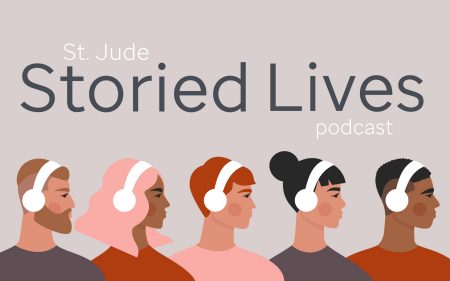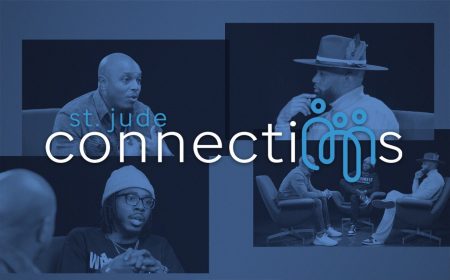
With treatment at St. Jude and bolstered by a promise to himself, Monk overcame bone cancer
After losing his left leg below the knee to bone cancer, Monk found strength, purpose and a new path forward — one determined step at a time.

July 21, 2025 • 5 min

Before the sun had begun to stretch across the Memphis sky, Monk was already awake. It was still dark outside, but inside his mind, the lights were on — flickering, racing.
He was 14 years old, and today, he would lose his left leg below the knee — foot and all.

He lay in bed at Tri Delta Place, the short-term housing for families at St. Jude Children’s Research Hospital®. His four older siblings had come to Memphis, Tennessee, to be near him and provide support. But in that moment, it was just Monk, alone with his thoughts.
He imagined he’d still play football, basketball, four-wheelers, all of it. He’d always been fast, always been a competitor. But would he ever do it like before?
So, he got up. Slipped out into the early morning air and found the basketball court. And there, alone, he played.
He dribbled. He dodged. He spun. He played against fear, against bone cancer, against the idea that the childhood part of his life was ending.
With all the eloquence his 14-year-old self could muster, Monk had this thought:
“I’m not going to let anything keep me down. I’m not going to be a sad, mopey type of person. Life is way too short to just mope around and be a sad sack of nothing.”
Call it Monk’s Creed. That was April 2018, and it’s guided him ever since.
When it was time to drive across campus, his parents assumed he’d ride with them. But Monk refused.
He wanted to use his own two feet, one last time.
“So, instead,” Monk said, “I ran.”
The diagnosis
The story had started months earlier, at a bonfire in his West Tennessee small town, when Monk twisted his ankle. Nothing unusual for a kid who lived on fields and courts. Ice it. Elevate it. Walk it off.
But the pain didn’t walk off. Then came the fall at his mom’s workplace. The ER visit. The X-ray.
On the morning of his appointment with the bone specialist, his parents gently told him: The scans had revealed a tumor in his ankle.
Monk cried. Of course he did. But then he was referred to St. Jude.
On the day he arrived, he saw two kids, bald and laughing, chasing each other outside like it was recess.
“It shocked me,” Monk said. “They were happy. Even in that situation.”
So, maybe he could be happy, too.
Monk was diagnosed with osteosarcoma, the most common type of bone cancer in children and teens.
He asked his oncologist: “Am I going to lose my foot?”
She was honest. Reconstruction wasn’t possible because of the advancement of the disease. In addition to chemotherapy, Monk’s treatment would include a below-the-knee amputation of his left leg.
But he would have a prosthetic. He could walk again.
He was scared until he remembered a girl from a nearby town who had a prosthetic leg and played basketball better than anyone.
“She played like Steph Curry,” Monk said. “Gave our team fits every time we played her.”
The fear began to loosen its grip.

The recovery
At St. Jude, Monk played NBA 2K, a basketball video game. Not alone, though. There was almost always someone around with a few minutes to spare and a competitive streak. And together, they’d sit. Cracking jokes. Trading buckets.
It was so easy for Monk to make friends at St. Jude.
“We just had fun,” Monk said.
Today, he has a hard time explaining to people that St. Jude was one of the happiest times of his life — because of the people there.
People like Bridget, a younger patient with the same diagnosis, made the difference. Monk had started treatment a few weeks before her. Without being asked, he began to guide her through what was coming.
He checked in with her frequently and explained what to expect in the next treatment phase. He cracked jokes.
“Just trying to keep her and her mom’s spirits up,” he said.
Jamie, Bridget’s mother, remembers watching him and marveling at how he carried himself.
“He was so mature. So independent. And he still found a way to make people laugh.”
After he got his prosthetic leg, walking didn’t feel natural. Despite the encouragement of St. Jude physical therapists, he remembers thinking: “I’m never going to walk normal again.” That was his lowest point.
Then Bridget, still recovering from her own surgery, got up on crutches before he did.
“Come on, slow poke,” she teased. “Are you going to sit in a wheelchair, or are you going to get on some crutches?”
He laughed. Then he got up.

And from that day on, he practiced — through the house, down the halls — until he didn’t need crutches anymore.
The climb
Shaped by the people at St. Jude who challenged him — not with pity, but with expectations — Monk is, in many ways, self-made.
He began working at 15 at various jobs because he wanted to push himself.
At 18 he worked for two years at a Tennessee shipping and freight company, where the work demanded stamina and focus. Every box he lifted tested his resolve, and he liked it that way. When others slowed down, Monk kept moving — box after box, steady and relentless, sweat soaking through his shirt.
He needed the crew to see his strength first, before they saw his prosthetic leg. He didn’t want anyone to go easy on him.
So during those first weeks on the job, he wore long pants, even in the thick of summer. People noticed. He said nothing. He didn’t want the first thing they saw to be what he had lost.
Only after he had proven himself did he show up in shorts.

That’s when they saw it: just below the knee, the prosthetic leg. The leg that had carried every load.
“It just blew everyone’s mind,” he said.
During the pandemic, he tried college classes online, but they didn’t feel like learning.
“I felt like I could learn more by getting out into the world,” he said. “Trying different jobs. Picking up different skills.”
So, he chased opportunities and kept moving forward.
Recently, he landed a job at a factory that makes batteries for electric vehicles. Ten thousand people applied. Monk got in early — part of the first wave.
“I think that was another blessing,” he said. “We’re top seniority.”
He helps his father fix cars. He cares for his nieces and nephews. And he has dreams.
He’s building credit, saving money and planning with his brother to buy land — to build homes for their family, from the ground up.
He’s only 21.
And on Sunday afternoons, he’s back on the basketball court with his friends — dodging, laughing, making plays.
Pity him or don’t. He’ll beat you either way.
“I don’t want to sound like that guy,” Monk said, “but I’m pretty good.”







